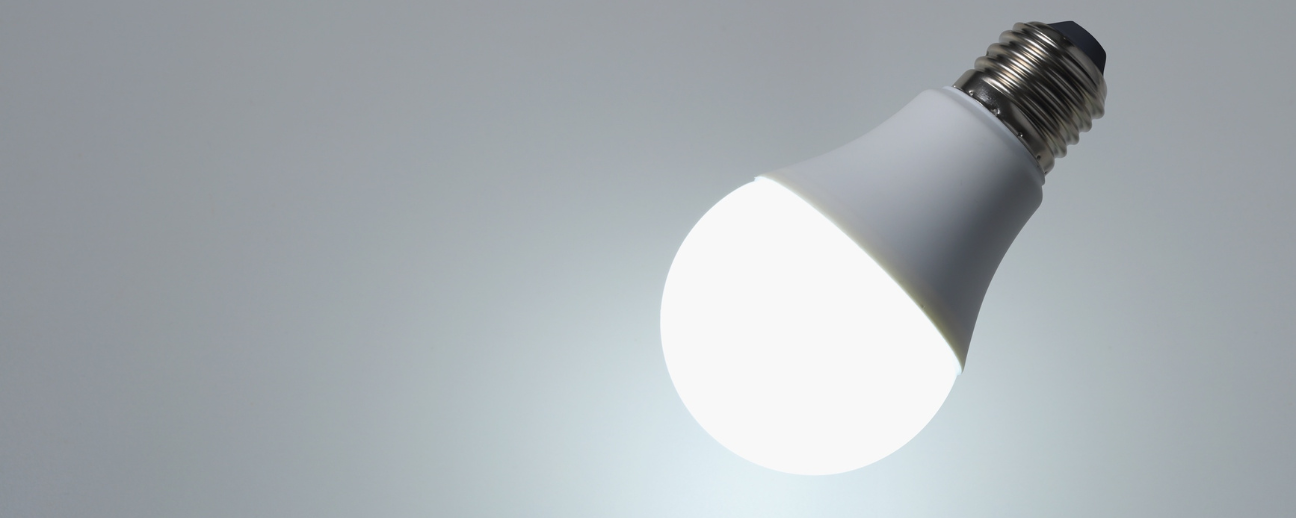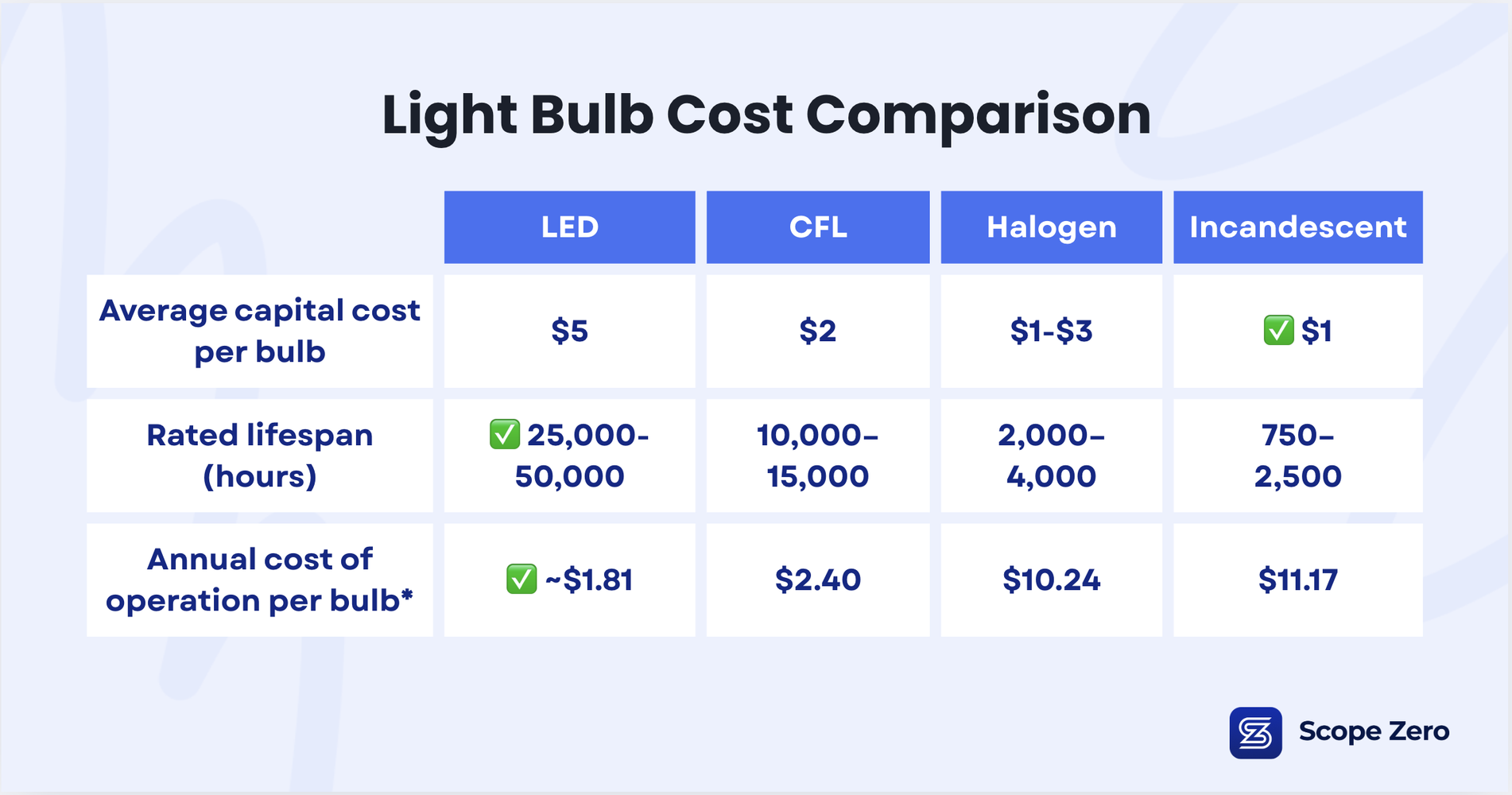May 28, 2025 • 8 min read
LED Light Bulbs: A Smart Upgrade to Cut Energy Costs

LED light bulbs have emerged as one of the simplest and most effective upgrades for households looking for ways to reduce energy costs and environmental impact. They’re longer-lasting, more energy-efficient, and available in a wide range of styles for every room in your home. Whether you’re new to personal sustainability or looking to save costs at home, switching to LED light bulbs is an easy, affordable place to start.
Table of Contents
Why Switching to LEDs is a Smart Choice for Your Home and Wallet
LED bulbs offer the desired combination of financial savings and environmental benefits. Upfront costs of LEDs are slightly higher than incandescent or compact fluorescent lamp (CFL) bulbs, but they pay off quickly by cutting your energy bill and lasting far longer than traditional bulbs. By making this simple switch, you reduce your home’s carbon emissions and start seeing real financial savings.
What are LED Light Bulbs?
LED stands for light emitting diode. Unlike incandescent bulbs, which heat a metal filament to produce light, or CFLs that use gas and mercury vapor, LEDs produce light through the movement of electrons in a semiconductor. This process is far more energy-efficient and durable.
Because LEDs generate light through electroluminescence rather than heat, they convert a much higher percentage of energy into visible light — minimizing wasted energy. Additionally, LEDs have no fragile filaments or glass enclosures that can break easily, which makes them more resistant to shocks, vibrations, and frequent switching. This contributes to their longer operational life and lower maintenance needs compared to traditional bulbs.
How LEDs Differ from CFL, Incandescent, and Halogen Bulbs
Compared to other lighting technologies, LEDs offer superior performance across several key areas. Incandescent bulbs waste up to 90% of their energy as heat, making them highly inefficient. CFLs use less energy than incandescents but contain small amounts of mercury, which requires careful disposal and poses health and environmental risks. Halogen bulbs are a marginal improvement in efficiency over standard incandescents but still fall short in longevity and performance.
LEDs outperform all three by delivering higher energy efficiency, greater safety, and significantly longer lifespans, often lasting 10 to 25 times longer than traditional bulbs.

*Estimates based on 3 hours of daily use at an average electricity rate of $0.17 per kilowatt-hour.
The Benefits of LEDs
LEDs provide instant brightness, emit little heat, and are built to last. Here are the top benefits of using LED light bulbs in your home:
Energy efficiency and cost savings
LEDs use up to 75% less energy than incandescent bulbs and can last over 25 times longer, providing more than 10,000 hours of use. Switching to LEDs reduces electricity demand, which in turn lowers greenhouse gas emissions from power plants. Less frequent replacements also means fewer materials go to landfills.
Improved lighting quality and comfort
LED bulbs come in a range of brightness levels and color temperatures, from cozy warm whites to crisp daylight tones. Because of their efficiency, they offer more brightness per watt and begin illuminating instantly without warm-up time. High-quality LEDs have a Color Rendering Index (CRI) of 80+, ensuring accurate color visibility similar to natural light.
Longer lifespan and lower maintenance costs
An LED bulb can last over a decade under normal household usage. That means fewer trips to the store, fewer bulb changes, and fewer disruptions in your lighting setup. Less frequent replacements also mean fewer materials go to landfills.
Tips for Choosing the Right LED Light Bulbs
Bulb Shapes and Base Types
When shopping for LED bulbs, it’s important to choose options that match your fixtures and lighting preferences. Start by selecting the right bulb shape and base type. For example, A19 bulbs are ideal for standard lamps and ceiling fixtures, BR30 bulbs work well in recessed lighting, and MR16 or GU10 are typically used for track lighting. Base types vary too: E26 is the standard screw-in base, E12 fits candelabra sockets, and GU24 uses a twist-lock mechanism. Always check your fixture before purchasing new bulbs.
Brightness and Color
For brightness, look for bulbs with at least 800 lumens, which is equivalent to the brightness of a traditional 60-watt incandescent bulb. In terms of color, 2700K to 3000K provides a warm white glow that most people prefer for living rooms and bedrooms, while 3000K to 4000K is better for bathroom and kitchens. To ensure natural and vibrant color appearance, choose bulbs with a CRI (Color Rendering Index) of 80 or higher.
Dimmability
If you want adjustable lighting, make sure the LED bulb is labeled dimmable and confirm compatibility with your dimmer switch. Using a non-dimmable LED bulb in a dimmer switch will either result in the bulb not adjusting or damaging the bulb.
Smart Bulb Functionality
For tech-savvy households, smart bulbs offer added functionality like app-based control, scheduling, and voice assistant integration. This helps you conserve energy with little additional effort and adds a great deal of convenience once set up.
Installing LED Light Bulbs
To get the most impact from your LED upgrades, start with high-use areas such as kitchens, bathrooms, hallways, and exterior lighting. These spaces typically see the most daily activity, so swapping in efficient bulbs yields faster energy and cost savings.
Your choice of fixture also influences lighting effectiveness. Reflector-style bulbs like BR30 or PAR38 are designed to direct light downward, making them ideal for recessed ceiling fixtures. In contrast, globe or standard-shaped bulbs diffuse light more broadly, which works well in open areas or decorative fixtures.
You should also tailor your lighting to its purpose. Use cooler, brighter LEDs (higher kelvin rating) for task-oriented areas like kitchens or reading nooks, while warmer LEDs create a comfortable ambiance in bedrooms or living rooms. To boost efficiency even further, pair your LEDs with occupancy sensors in lesser-used areas like closets, or install dimmers to control light levels and reduce energy use when full brightness isn’t needed.
Using and Maintaining LEDs
To maximize the longevity of LED light bulbs, avoid placing them in enclosed fixtures unless rated for that use, as heat can reduce lifespan. Use voltage-stable power sources to prevent surges. You should also dust bulbs regularly with a soft cloth to maintain brightness and efficiency. For built-in fixtures, gently vacuum or wipe reflectors to maximize light output.
When your light bulb reaches its end of life, ensure proper disposal so you don’t introduce any environmental contaminants. Incandescents and halogens can be placed in your trash, but wrap them to prevent breakage. CFLs must be recycled due to mercury content, and LEDs contain small electronic parts that require recycling at e-waste centers or participating retailers. You can find places to recycle your bulbs at Earth911.
One final point to remember, even though LEDs consume less energy than incandescent lights, keeping your LEDs on all the time is not better than using incandescent lights only when you need them. Be sure to turn off your LEDs when you are not using them.
How Much You Can Save by Switching to LEDs
Replacing one 60W incandescent with a 10W LED could save you around $9-$10 annually per bulb. LEDs may cost $2-$5 up front, but can save over $50 in electricity and replacement costs over their lifespan. If a typical home replaced 15 inefficient bulbs with LEDs, they could save $140 per year on energy costs, 821 kWh of electricity use annually, and over 636 pounds of carbon emissions. In contrast, incandescents burn out within 1,000 hours and require frequent replacement. Most households recover their investment in LEDs within a year due to lower utility bills.
Recommended LED Light Bulbs
Looking to upgrade bulbs in your home with LEDs? Here are our top recommended replacement bulbs:
GE Cync 60 Watt EQ A19 Full Color Dimmable Smart LED Light Bulb
GE LED BR30 Indoor Flood Light Bulb
GE Cync Outdoor 90-Watt EQ PAR38 Dimmable Smart LED Spot and Flood Light Bulb
More Easy Wins for Cutting Your Energy Bills
LEDs are just the beginning when it comes to saving energy at home. If you're looking for other simple, high-impact upgrades, explore our top five easy ways to reduce utility costs and improve efficiency. Want to go further? Check out our complete guide to home energy efficiency for deeper savings opportunities.
Scope Zero’s Carbon Savings Account® (CSA) helps you take action with confidence. It makes it easy to identify and afford upgrades to your home and transportation that reduce your carbon footprint and lower your monthly bills. Learn how the CSA can support your sustainability goals while saving you money.
LED Lighting FAQs
Are LED light bulbs more cost-effective than incandescent?
Yes, while LED bulbs cost more upfront, they use about 75% less energy and last up to 25 times longer than incandescent bulbs. Over their lifespan, this makes LEDs up to 5 times more cost-effective and fully offsets the initial investment.
How much can you save with LED light bulbs?
Depending on usage, each LED bulb can save $9-$10 per year compared to an incandescent bulb. For a household with 40 bulbs or more, that’s as much as $400 in annual savings, plus fewer replacements needed.
What is the disadvantage of LED light bulbs?
The main drawback of LED bulbs is their higher upfront cost. Additionally, not all are compatible with dimmers or enclosed fixtures.
Drive positive outcomes for your wallet, your home, and the planet
Scope Zero’s Carbon Savings Account® (CSA) helps individuals lower their cost of living by making home and personal transportation upgrades affordable and accessible. The CSA is a financial wellness benefit that reduces cost of living, drives environmental impact, and engages employees in sustainability.
Join our community
Sign up for our newsletter to stay up-to-date on all things Scope Zero.







 Platform
Platform




